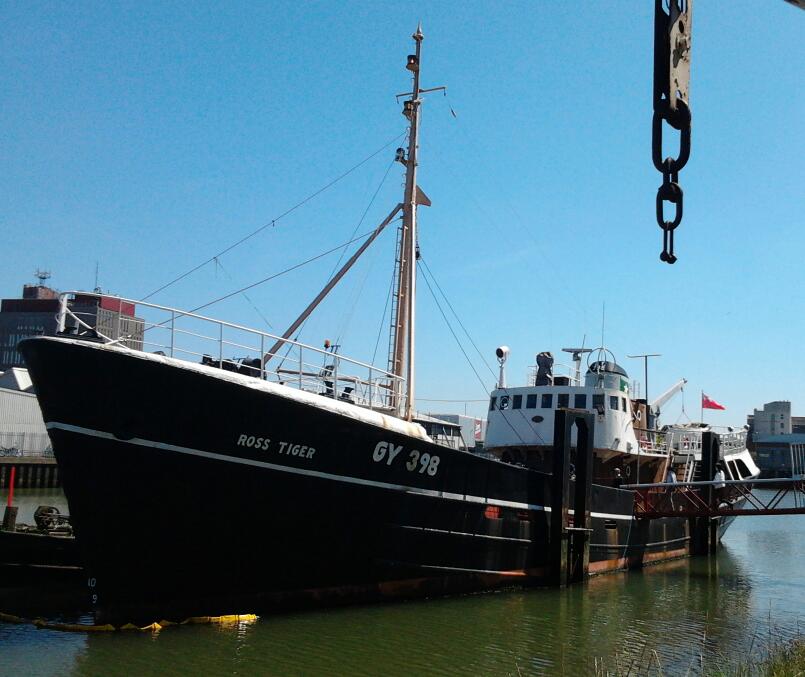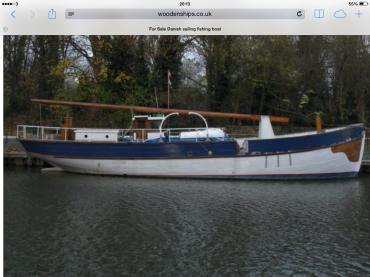


Previous names
- 1985 - 1991 Cam Tiger
Details
Construction
Dimensions
History
ROSS TIGER is thought to be the oldest middle-deep water fishing vessel left in the country, and the only large side trawler left with the capacity to fish from both port and starboard sides. She provides a unique glimpse into the astonishing working environment of what was then the most dangerous job in Britain.
Following the 1956 celebrations of the Grimsby Fish Docks centenary, where material published for the event describes Grimsby as 'The World's Premiere Fishing Port', Ross Trawlers ordered twelve new middle-deep water fishing vessels to add to the firms fleet.
ROSS TIGER was completed in 1957 as a middle-deep water fishing vessel - a vessel designed primarily to fish the North Sea, Faroe Isles and Norwegian Coast but with the ability to fish further north into arctic waters during the summer months.
She was built at the end of a long period of trawler evolution that started with the introduction of steam trawlers in the late 19th century. Ships had to evolve to cope with the seas and climates of the northern fishing grounds now that the technology existed to make such voyages possible. Trawlers saw the creation of a 'whaleback' that gave covered protection at the forward end of the fish deck. 'Bridge-aft side' trawlers, with wheelhouses abaft the funnel, were lost to wheelhouses located further forward with clear views of the exposed fish decks, incorporating wheelhouse verandas for the skipper and mate to observe from. Small wooden wheelhouses with forward verandas were then replaced with stout, solid curved steel fronts to stand up to the heavy punches the North Sea had to offer. Port side fishing was abandoned in the mid 1960's, possibly for health and safety reasons that allowed for men to learn one side well and not become confused with the mirror image effect of fishing the opposite trawl. Trawlers were then designed with an enclosed port quarter to make use of areas where trawl gallows were once situated. Eventually the stern trawler with processing areas below decks came into more common usage in the later 1960s. This saw the working environment of a trawlerman change forever; 18 hour days of reaching over waist-high bulwarks in rolling seas and gutting up to 2 tons of fish from a single hall on windswept, exposed decks without safety lines was now becoming a thing of the past.
Built in the second half of the 1950's, ROSS TIGER is old enough to retain features of the trawlers much older than her - an entirely riveted hull with the sheer and camber of the traditional vessels, mahogany panelling and an open port quarter. The 1960's saw these ships change forever and ultimately vanish altogether.
An update from Grimsby Fishing Heritage in March 2021 reported that they've been able to undertake quite a few things aboard ROSS TIGER recently with some funding and their own budgets; the biggest job being a survey of the mast and subsequent renovation, which went well and no major issues were identified. They have also been conserving ROSS TIGER's interior and re-painting all of the vessel's upper super-structure and steel decks.
Significance
- What is the vessel’s ability to demonstrate history in her physical fabric?
Evidence for designs, functions, techniques, processes, styles, customs and habits or uses and associations in relation to events and people. How early, intact or rare these features are may impact on significance.
ROSS TIGER is a rare example of traditional east coast ship building skills from Cochrane and Sons of Selby. With timber decks, an entirely riveted hull and casings, she demonstrates bygone lines with her iconic sheer and camber. ROSS TIGER is built to an earlier style with the capacity to fish from both port and starboard sides. This gives a strong understanding of the working environment of the most dangerous peacetime occupation in the UK aboard a ‘conventional sidetrawler’. The ship still contains her original 1956 RUSTON of Lincoln 7VG BXM 780HP marine diesel engine which is one of the earliest marine diesels to be fitted to a ‘conventional side-winder’ and survives intact with period Napier turbo equipment. She demonstrates quality craftsmanship and materials, evident particularly in the mahogany panelled master’s cabin, with mahogany fitted furniture. This is reminiscent of the traditional cabins in trawlers much before her time and preserves a special atmosphere. The fittings in the main cabins, mess room, galley and bathrooms are all largely original and the galley has what is believed to be the original Esse range which was initially coal/anthracite fired. The fish deck/weather deck is a timber deck of ‘Borneo pine’ laid above riveted steel deck plates. Originally the decks were treated with ‘chloride of lime’, which would give them an almost white appearance which contrasted strongly with the black pitch lines between the planks. The bridge/wheelhouse is of the sturdy steel and aluminium construction that replaced earlier wooden structures with ‘bridge verandas. The ship retains important original machinery and period trawling equipment specific to her era, helping visitors understand the nature of 1950s trawling practices.
- What are the vessel’s associational links for which there is no physical evidence?
Associations with people or places. Off-ship research.
ROSS TIGER is Great Grimsby’s last remaining side-winder/side-trawler and serves as a memorial to those lost from the town in the most dangerous peacetime occupation in the UK. Grimsby alone lost 21 vessels between 1950 to 1957 when ROSS TIGER was built. Due to these dangers, ROSS TIGER was designed to be the very latest in stability and safety. Ross Trawler’s Ltd even went so far as to produce a safety film in 1969 to promote safety at sea on fishing vessels. It featured a similar ship of the smaller and now extinct ‘Bird Class’, ROSS MALLARD. ROSS TIGER represents key developments made to trawler design that were pioneered at the port of Grimsby and helps to illustrate this story. The ship was built as the first of twelve ‘Cat Class’ vessels as a response to the 1956 Grimsby Fish Dock Centenary celebrations when Grimsby was hailed as ‘The World’s Premier Fishing Port’ and “the Mecca of the World’s fish trade”, which amongst other things led to establishing fish and chips as a British institution. ROSS TIGER was the last side trawler in Grimsby to shape the town, with many houses built in response to the rapid growth of the fishing industry. Great Grimsby played a huge role in the survival of the nation in both world wars through mine sweeping operations, a task which was performed using sidewinder fishing vessels like ROSS TIGER. She has lived and worked from the Humber all of her life giving her a strong regional connection to the area and still remains in the same setting alongside at the port of Great Grimsby today.
- How does the vessel’s shape or form combine and contribute to her function?
Overall aesthetic impact of the vessel, her lines, material she was built from and her setting. Does she remain in her working environment?
ROSS TIGER is striking due to her pronounced sheer, accented with a white painted ‘sheer stripe’ along the length of her hull as part of her original livery. This profile is distinct and unique to this era of trawlers. Of all those built in the boom time of the 1950s, incredibly, ROSS TIGER is the last remaining diesel side-winder of this decade. Her decks are cambered towards the waterways along her bulwarks and her pronounced sheer allowed the seas on her fish deck to flow aft, towards a stepped area in front of the winch. This area is referred to as the ‘duck pond’. As the ship naturally rolls, the water pours through a large scupper in the bulwark at this position. ROSS TIGER was built for both port and starboard fishing. As a result of this the weather deck on her port side extends to her port quarter, where the after trawl gallows and towing block would be situated. Ships built only shortly afterward, such as Hull’s ARCTIC CORSAIR, have this space on the port side enclosed to give greater internal accommodation. The alarmingly low bulwarks, particularly amidships, enabled the crew to reach over the rails at hauling time to retrieve the trawl, often standing waist high in seas with arctic winds directly into their faces and hands. The ship has a forward ‘whaleback’, which was a development made to the first steam trawlers in the town around the turn of the 20th century. It is essentially a covered area to provide shelter for some tasks and for emergencies. There was otherwise no shelter on deck and the only way to enter crew accommodation spaces internally was through a single ‘storm door’ at the extreme aft end of the deck. ROSS TIGER has an aluminium deck head to her wheelhouse and an aluminium centre to the wheelhouse frontage. This is both light-weight and allows for minimal interference with the ship’s two compasses. Original railings to the bridge top, again aluminium, survive. ROSS TIGER’s design saw the ‘bridge verandas’ retained, at the sides of the wheelhouse, as a reminder of a previous era where the trawler officers would observe activities on deck, such as the ‘shooting and hauling’ of the trawl.
Sources:
- http://www.fishermensmission.org.uk/our-work/emergency/
- Boswell, David. (1969) Loss List of Grimsby Vessels 1900-1960, Grimsby: Grimsby Public Libraries and Museum. P.65
- Herman, Leslie. (1956) Article within Grimsby Fish Docks Centenary Exhibition, Fish Trades Gazette for the Grimsby Fish Dock centenary Council. P.7
- Quinn, Matt. (1956) Article within Grimsby Fish Docks Centenary Exhibition, Fish Trades Gazette for the Grimsby Fish Dock centenary Council. P.3
- Ross Group (1957) Inside front cover illustration within County Borough of Grimsby Official Guide, London; Batiste Publications Ltd.
- Herman, Leslie. (1956) Article within Grimsby Fish Docks Centenary Exhibition, Fish Trades Gazette for the Grimsby Fish Dock centenary Council. P.7
- Quinn, Matt. (1956) Article within Grimsby Fish Docks Centenary Exhibition, Fish Trades Gazette for the Grimsby Fish Dock centenary Council. P.3
- Ministry of Information for The Admiralty (1943) His Majesty’s Minesweepers, London: His Majesty’s Stationary Office. P.22
Prime Minister’s Speeches, National Archives Ref PREM 3/314/5
Own this vessel?
If you are the owner of this vessel and would like to provide more details or updated information, please contact info@nationalhistoricships.org.uk













